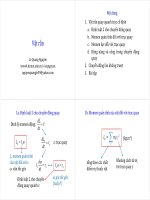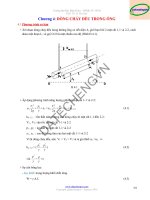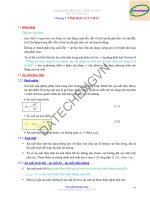Giao trinh bai tap qh 5
Bạn đang xem bản rút gọn của tài liệu. Xem và tải ngay bản đầy đủ của tài liệu tại đây (180.35 KB, 5 trang )
Ch-3: Fourier series representation of periodic signals
P3.1. For the signals f(t) and x(t) depicted in Figure P3.1, find the
component of the form x(t) contained in f(t). In other words find
the optimum value of c in the approximation f(t)≈cx(t) so that the
error signal energy is minimum. Find the error signal e(t) and it
energy Ee. Show that the error signal is orthogonal to x(t), and that
Ef=c2Ex+Ee. Can you explain this result in terms of vector?
Signal & Systems - FEEE, HCMUT – Semester: 02/10-11
Ch-3: Fourier series representation of periodic signals
P3.2. Repeat P3.1 if x(t) is sinusoid pulse shown in Figure P3.2.
P3.3. If x(t) and y(t) are orthogonal, then show that the energy of
the signal x(t)+y(t) is identical to the energy of the signal x(t)-y(t)
and is given by Ex+Ey. Explain this result using vector concepts. In
general, show that for orthogonal signal x(t) and y(t) and for any
pair of arbitrary constant c1 and c2, the energies of c1x(t)+c2y(t) and
c1x(t)-c2y(t) are identical, given by:
c12 E x +c 22 E y
Signal & Systems - FEEE, HCMUT – Semester: 02/10-11
1
Ch-3: Fourier series representation of periodic signals
P3.4. Figure P3.4(a) shows the first eight functions in Walsh function
set. Represent f(t) in Figure P3.4(b) over interval [0,1] using a Walsh
Fourier series using 8 basis functions. Compute the energy of e(t), the
error in the approximation using the first N non-zero terms in the series
for N=1, 2, 3 and 4.
Signal & Systems - FEEE, HCMUT – Semester: 02/10-11
Ch-3: Fourier series representation of periodic signals
P3.5. Determine the cross-correlation of the following signals:
x(t)=rect( 2Tt ), and y(t)=e-at u(t);a>0
P3.6. Determine the cross-correlation of the following signals:
x(t)=e-t u(t), and y(t)=e-2t u(t); a > 0
P3.7. Consider the signal f(t)=rect(t-1/2). Determine its
autocorrelation function and its energy using this function
P3.8. Find the autocorrelation of the signal f(t)=cos(ω0t)rect(t/T)
Signal & Systems - FEEE, HCMUT – Semester: 02/10-11
2
Ch-3: Fourier series representation of periodic signals
P3.9. A continuous-time periodic signal f(t) is real valued and has a
fundamental period T=8. The nonzero Fourier series coefficients fo
f(t) are: D1=D-1=2, D3=(D-3)*=j4.
Express f(t) in the form:
+∞
f(t)= ∑ C n cos(ωk t + ϕn )
n =0
P3.10. Using the Fourier series analysis to calculate the coefficients
Dn for the continuous-time periodic signal
1.5; 0 ≤ t<1
f(t)=
-1.5; 1 ≤ t<2
with fundamential frequency ω0=π
Signal & Systems - FEEE, HCMUT – Semester: 02/10-11
Ch-3: Fourier series representation of periodic signals
P3.11. Determine the Fourier series representation for each of the
periodic signals depicted in Figure P3.11.
Signal & Systems - FEEE, HCMUT – Semester: 02/10-11
3
Ch-3: Fourier series representation of periodic signals
P3.12. In each of the following, we specify the Fourier series
coefficients of a continuous-time signal that is periodic with period
4. Determine the signal f(t) in each case.
0;
(a) D n = n
(j)
sin(nπ /4)
nπ
(b) D n =(-1) n
sin(nπ /8)
2nπ
n=0
; otherwise
jn; |n|<3
(c) Dn =
0; otherwise
1; n even
(d) D n =
2; n odd
Signal & Systems - FEEE, HCMUT – Semester: 02/10-11
Ch-3: Fourier series representation of periodic signals
P3.13. Consider a continuous-time LTI system whose frequency
response is
+∞
sin(4ω )
H(jω)= ∫ h(t)e-jω t dt =
-∞
ω
1; 0 ≤ t<4
If the input to the system is a periodic signal f(t)=
-1; 4 ≤ t<8
with period T=8, determine the corresponding system output y(t)
P3.14. Consider a continuous-time ideal low-pass filter whose
frequency rsponse is
1; |ω| ≤ 100
H(jω )=
0; |ω|>100
When the input to this filter is a signal f(t) with fundamental period
T=π/6 and Fourier series coefficients Dn, it is found that
f(t) → y(t)=f(t)
For what values of n is it guaranteed that Dn=0?
Signal & Systems - FEEE, HCMUT – Semester: 02/10-11
4
Ch-3: Fourier series representation of periodic signals
P3.15. Consider an LTI system with impulse response h(t)=e-4tu(t).
Find the Fourier series representation of the output y(t) for each of
the following inputs:
(a) f(t)=cos(2π t)
(b) f(t)=sin(4π t)+cos(6π t+π /4)
+∞
(c) f(t)= ∑ δ (t − n)
n= −∞
+∞
(d) f(t)= ∑ (−1) n δ (t − n)
n= −∞
(e) f(t) is periodic square wave dipicted in Figure P3.15
f(t)
Figure P3.15
Signal & Systems - FEEE, HCMUT – Semester: 02/10-11
5









